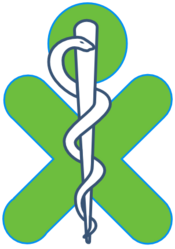TeleHealth Hardware: Difference between revisions
No edit summary |
|||
| Line 36: | Line 36: | ||
*Electrode offset tolerance: + - 320 mV dc (this is due to the fact the electrodes get polarized) |
*Electrode offset tolerance: + - 320 mV dc (this is due to the fact the electrodes get polarized) |
||
[http://wiki.laptop.org/go/Image:EKG.JPG |
[http://wiki.laptop.org/go/Image:EKG.JPG EKG Schematic] Tentative design similar to the above specs. |
||
=== Status === |
=== Status === |
||
Revision as of 04:40, 3 February 2008
Introduction
There are currently several groups working on Health sensors for the XO. Some are a simple as a temperature gauge that can be plugged into the audio-in port and used with Measure. But the eventual goal of Health Hardware is a $10USD USB device that can act as a full TeleHealth remote sensor package for pulse, temperature, blood oximeter, and many other simple sensors. This along with built in tools like the Webcam and Microphone it will allow doctors and Health Professionals to diagnose patients from hundreds of miles away. This would greatly stretch the abilities of limited resources for healthcare.
Sensors
EKG
Simple 3 lead EKG for arrhythmia and trauma diagnosis. Also facilitates pedagogical exercises into
Four parts:
- Connection: Electrodes connecting device to person
- Amplification: Multiplies the voltage of the heart's electrical signal into something computer-usable
- Opto-Isolation: Protection circuits
- USB ADC: Inputs data to the XO
Main Chipset
The AD8541/2/4 series op-amps fulfill the target specs perfectly.
Target Specs
- Low frequency: -3 db @ 0.1 Hz
- High frequency: -3 db @ 45 Hz
- Patient leakage current: <10 µA with acquisition module connected (meets AAMI standard SCL 1278)
- Chassis leakage current: <100 µA (meets AAMI standard SCL 1278)
- Common mode rejection: 130 dB minimum with balanced leads. With 5Kohm imbalance 100dB
- A/D conversion: 10-12 bits
- Impedance: 100 Mohm, defibrillator-protected (optional for the XO)
- Signal Dynamic range: 10 mV
- Electrode offset tolerance: + - 320 mV dc (this is due to the fact the electrodes get polarized)
EKG Schematic Tentative design similar to the above specs.
Status
- Current problems include tuning op-amps and prototyping.
- Determine efficient alternatives to the classical electrodes.
Pulse Oximeter
An invaluable piece of medical equipment relaying information about pulse and oxygen saturation by analyzing the output of two filtered photo-diodes in two different frequencies. The pulse oximeter operates on the theory that oxygenated and deoxygenated hemoglobin have different absorption and reflection frequencies. The same principle can be applied to any other small organic molecule with identifiable spectra, with proper calibration.
Hardware
Currently nonfunctional design consists of two MAX4006 OpAmps (designed for telecom photo-diodes) connected to an IR and a red filtered photo diode outputting a measurable voltage. A finger would be positioned between the photodiodes and a red and IR LED.
- Main Chipset: MAX4006 Op-Amp
Problems
- Once again, op-amp tuning
Stethoscope
A simple microphone and audio amplifier to pick up heart, lung and bowel sounds.
Hardware
- Button Mic
- Audio amplifier
- Shielded twisted-pair cable
- Mic plug
ADC
- MCU Specs
- Speed: 25+ MIPS
- 5 or more channels of ADC
- 10 or 12 bits of ADC
- 5V, 100ma or less
- USB
- Price, less than 6usd
- User:Mchua and User:Nlee have offered assistance
- BIG STRUGGLING POINT
- X.Looking at the C8051F321 until an alternative is found.X
- Now looking at the PIC18F2455/2550/4455/4550, a commonly used MCU supporting multiple channels of 10b ADC and USB
Power Supply
Due to the nature of medical instrumentation as necessitating high-precision power supply, some combination of a regulator chip, fuse, and smoothing capacitor are needed.
Hardware
- Main Chipset: LP2982
- LP2982 5, 4.5, or 3v regulator
- Over-voltage protector
- Fuse
- USB Connector
- Shielding
Get Involved
Your help is very welcome in this project. If you would like to participate in the Health Jam in Seattle around early April we are looking for organizers and participants.
- Provide talent, time, or treasure:
- If you have experience designing medical instrumentation, and are willing to mentor or assist high school age students...
- If you have extra time and are able to send emails, track down sample components, or raise awareness...
- If you don't know what to do with your old soldering iron, oscilloscope, or components collection...
- Program! We're in need of PIC and python programmers.
People
DyD has been working on designing (and learning everything needed to design) a TeleHealth Module for several months Mel Chua has been working on the project as well, and is organizing a Health Jam in April to complete the project Seth Woodworth is the man on the ground in Seattle getting resources organized for the upcoming Health Jam
